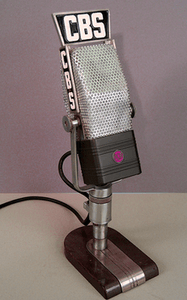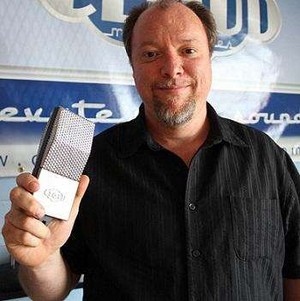Among the more lamented departures from the world of electronics was RCA’s microphone business. A few years ago I visited the college radio station where I’d worked in the 80s, and one of my former professors was proudly showing off an RCA 44A ribbon microphone the school had acquired. Though it had a few dents and scratches, it was a work of art. Soon after I saw it, the university’s music department borrowed the mic for recording sessions and never gave it back.
A typical RCA 44A ribbon microphone
(Source: Wikipedia)
Like original McIntosh MC275 amps, old ribbon microphones are collected because, when used correctly, they produce sounds hard to get elsewhere. But eventually even the vintage electronics section of eBay runs dry.
One of the companies helping to provide new ribbon microphones and preamps, Cloud Microphones, has been able to continue the work RCA did through collaboration between a musician/businessman, Rodger Cloud, and Stephen Sank, son of RCA’s ribbon microphone designer Jon R. Sank.
Jon Sank had done design work at RCA that included the BK-10A and the BK-11. When he passed away in 1998, he left Stephen with the knowledge and other tools to continue the ribbon microphone work that RCA had left behind.
Cloud came to Tucson as a singer/songwriter and started getting involved with bands and recording music. Sank moved into an office suite next door to Cloud’s studio, and in 2006 they started working together.
“So we collaborated on the initial designs of some of the mics, and I worked with him first refurbishing the vintage mics and so forth, and I really fell in love with the technology as it was in the 1930s and 1940s. It was just pretty darn great,” Cloud told me. “However, there were certainly challenges with the technology, most notably those types of microphones had a really weak sensitivity and are really difficult to deal with in terms of amplifying them.”
Cloud said that even with exceptional amplifiers, it was very difficult to use ribbon microphones to record some softer sounds because of the gain requirements. This led Sank and Cloud to develop the JRS-34 ribbon microphone, named in honor of Sank’s father and noting the year he was born.
Rodger Cloud with his version of the RCA mic
“As we worked on it, I really felt the need for an active microphone,” Cloud said. “And we really pushed ourselves to come up with something. We weren’t just coming up with something that was OK. It had to be absolutely audiophile quality.”
The result was a ribbon microphone that uses a Linear Systems LSK389 monolithic dual n-channel JFET to amplify the signal. Cloud wanted a dual JFET that would provide common-mode rejection in his amplifier, and settled on the LSK389. “It’s just the JFET that we like the best. The power requirements for the circuit are low. We tested all of them, and this is the one that seemed to give us the results we were looking for.”
Wiley Ross, who runs the recording studio at the University of Arizona, is a big fan of the Cloud’s gear. “I use the Cloudlifter almost always when recording from a passive microphone,” he wrote in a recent email to me.
“I don’t use it because I need the gain, I have plenty with my Millennia Media HV-3R, but because the sound is better; richer, more depth,” Ross wrote. “With the Cloudlifter Z it’s like having your mic locker expand to do all the different sonic possibilities afforded.”
Ross added that Cloud’s JRS-34 is a “main-stay” ribbon microphone. “I love it on all wind and brass instruments. Listening tests with other fine ribbons with faculty, students, and staff confirm its superiority.”
The Cloudlifter
Using a JFET-based circuit wasn’t an obvious solution at first, Cloud said. “We were looking at several options with the microphones, and I was the one who suggested that we try the JFET technology. We were also looking at chip-based technology, different ways we could activate the mic. One of the problems with a chip-based design was we were going to have to use a couple of nine-volt batteries. We just couldn’t figure out a way to get it to work on the phantom.”
Using the Linear Systems’ LSK389, which combines ultra-low noise with low IDSS , enabled Cloud and Sank to build a phantom-powered active ribbon microphone. Cloud said the prototype of the active circuitry was set up in a test box to enable testing various microphones. “And it only took a few moments to realize that this box is cool. And that’s how the Cloudlifter accidently came to be.”
The Cloudlifter is the active part of the company’s ribbon microphone broken out into a format that can be used with many microphones people already have, and it soon became the company’s best-selling product. “It’s a game-changer, or more accurately a ‘gain-changer,’ because it allows people to use microphones that they normally would not even consider for softer sources, acoustic instruments, because the problem in the past has always been defeating the noise floor of the preamplifier.”
The Cloudlifter is a standalone product customers could use to boost the gain of other microphones. It plugs into the line coming from a microphone and uses any standard phantom powered microphone input device to provide up to 25dB of “ultra-clean, transparent gain.”
The Cloudlifter is recommended for: recording direct into a digital audio workstation interface; working with noisy or low gain preamps; using mixers/preamps that impair the sound at higher gain settings; working with passive ribbon microphones or low-output dynamic microphones; capturing softer sound sources such as acoustic instruments and voice; and when using long cable runs.
When Cloud and his colleagues were first designing the circuit, they used Toshiba JFETs. “We found out about Linear Systems’ products so we tried and we compared it,” says Cloud. “We liked it better than Toshiba. It was still an improvement, and I liked what it did for the Cloudlifter — it seemed to drop the noise floor even further, which is always a good thing when you’re dealing with really low-sensitivity microphones.”
Cloud said that after sales increased for the Cloudlifter, it became too labor intensive to match the single LSK170 JFETs. “It was becoming almost a full-time job to hand-match these little JFETs, so we started looking at the duals, and we went to the surface-mount technology, and I’ve got to say the Linear Systems duals are awesome. We can’t match them that closely by hand, and the failure rate of the entire card as a whole is less than one in a thousand now. And we couldn’t achieve that making them by hand.”
The common-mode rejection enables the Cloudlifter to “pass clean audio in the worst of circumstances, next to a radio tower, in EMI hell,” according to Cloud.




